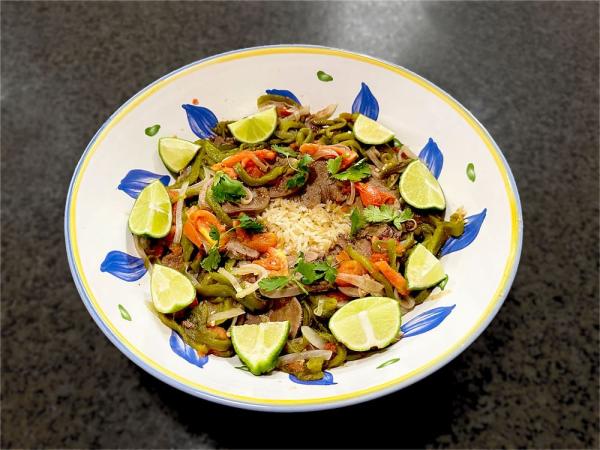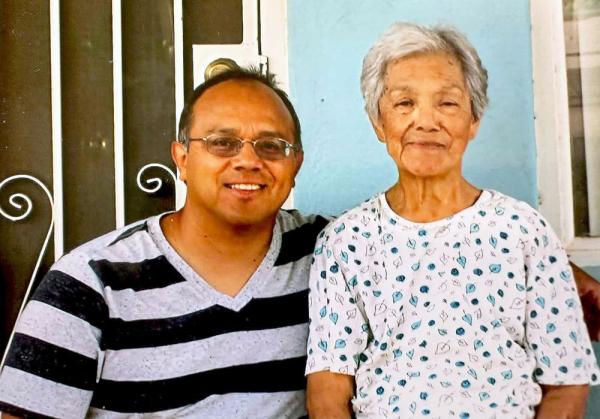
Beef Tongue
Submited by Jaime H. Pacheco-Orozco - General Manager, City of Los Angeles Department of Aging
About the Recipe
This meal is special for a number of reasons, not only because my mom taught me how to cook, but also because this meal symbolizes love, joy, hardship, sadness, and so much more. Let me explain.
My parents and my two oldest brothers came to the States from México in the 1950s with just a few pennies in their pockets. Life was tough, especially after the rest of us (one older sister and three more older brothers) were born in El Paso, Texas. After a decade or so, our family made the trek to California, for what was supposed to be a one-year stay; a stay, however, that spanned decade for my parents and my siblings. Over that course of time, my parents saw their children and grandchildren go to college, serve in the military, and start their careers and businesses near and far.
These comings and goings were times of joy and sadness for my parents. They were occasions to prepare special meals to celebrate the passing of time, to welcome us home and to see us off. When my parents finally returned “home” to the border towns of El Paso, Texas and Ciudad Júarez, Chihuahua, they left to care for our Abuelitas and they left their adult children behind. Whenever one of their children (and their families) visited them, my mom would prepare a meal in anticipation of their arrival. Similarly, whenever one of us departed back to our homes, my mom would prepare a final meal, “una comida de despedida.” And after this meal, we would receive their blessing, with a sign of the cross and a prayer for a safe journey back home. But, this meal also symbolized the “last meal” she would prepare for us.
This was the last meal my mom prepared for me and my family the last time we visited her on our last vacation before she passed away. Each time I make this meal, I think of my mom and my dad, and of my Abuelitas, and of the love they had for each of us. I remember the times we spent together in the kitchen, cooking, sharing stories, laughing, shedding tears. But, most of all, I remember their smiles and the twinkle in their eyes. With a simple meal, my mom gave so much.
Ingredients
Boiled Tongue
- 1 beef tongue (roughly 3 pounds)
- 12–14 quarts water
- 5 Bay leaves
- 2 tablespoons salt
- 1 tablespoon black peppercorns
- 1 head of garlic, unpeeled, sliced in half horizontally
- 1 onion, yellow, medium, cut in half horizontally
- 1 bunch mint (6 sprigs)
- 2 bunches cilantro (12 sprigs)
- 3 carrots whole, medium, unpeeled
Roasted Chiles, Tomatoes, Garlic
- 8–10 Anaheim chiles
- 4 jalapeño chiles, optional
- 4–6 tomatoes, unpeeled
- 6–10 cloves of garlic, unpeeled
Rice
- 1 tablespoon olive oil
- 2 cups Jasmine rice, unrinsed
- 4 cups water
- 2 teaspoons Knorr’s bullion
- 1 medium white onion
- 2 tablespoons olive oil
- 6–10 limes, cut into quarters
- Cilantro leaves for garnish
Directions
Tongue (Part 1)
- Before cooking the tongue, it must be rinsed and scrubbed thoroughly, by placing it in a large bowl in the sink, under running water. While rinsing and scrubbing the tongue, boil 6 to 7 quarts of water in a large stock pot.
- When the water is boiling, carefully transfer the tongue into the stock pot. Cover and cook for fifteen minutes.
- Remove the tongue from the boiling water and place into an 8 quart cast iron casserole.
- Add the bay leaves, salt, pepper, garlic, onion, mint, cilantro, and carrots.
- Fill with 6 to 7 quarts of fresh, cold water to cover the tongue (if possible).
- Cover, bring to a boil, then reduce to a simmer. Cook until the tongue can be pierced with a fork without resistance (about 2½ to 3 hours).
- Preheat the oven to 450°F.
- Rinse the chiles and tomatoes. Dry with a towel.
- Place parchment paper in a cookie pan, and then spread the chiles, tomatoes, and garlic over the parchment paper. Cook for 20 to 30 minutes, until the chili skins blister and/or become blackened.
- Remove from the oven. Let cool for five minutes, then start to peel the skin from the chiles, tomatoes, and garlic. Set aside until the tongue is cooked.
- In a medium size (2.5 quart) pot, heat one tablespoon of olive oil.
- Add the rice, stirring constantly until brown, being careful not to burn the rice.
- Add the bullion and cook for another minute or two.
- Add the water and stir to mix. Heat until water begins to boil.
- Cover and reduce heat to low. Cook for twenty minutes.
- Remove from the stove. Let rest for five minutes. Then uncover and fluff with a fork.
- The tongue can be removed from the simmering broth when it can be pierced with a fork without resistance. Remove the tongue with tongs and a carving fork, and place on a carving board. Set aside two cups of broth for later.
- The outer, white layer of the tongue must be removed while the meat is hot. If the meat is allowed to cool too much, removing the outer layer will be difficult. If the outer layer is difficult to remove even though the meat is hot, then the tongue must be cooked longer, usually no more than 15 minutes longer. To remove the outer layer, turn the tongue on its side, and with a sharp knife, pierce the outer layer. Then using your fingers, start to peel as if it were an orange. The meat will be hot, but the outer layer can be removed easily if the tongue is cooked thoroughly. Once peeled, set the tongue aside. Discard the outer layer.
- Cut the white onion in half, vertically. Place the onion flat side down and slice it into thin strips. Set aside.
- Remove the stem of the roasted chiles, and slice lengthwise into similar strips as the onions.
- Cut the tomatoes in half.
- Place the tomatoes flat side down, and cut into larger strips.
- Lay the tongue on its side on a carving board. The tongue can be viewed as three distinct parts, with the “front” of the tongue consisting of the long thin blade, and the rear of the tongue consisting of two parts, an “upper” and “lower” portion. Cut off the lower portion from the rear of the tongue. Slice the front and rear of the tongue into quarter inch to half inch thick medallions. Take the lower portion of the rear of the tongue, slice into similar size medallions, and then cut these into “rectangles” (nine pieces for each medallion).
- In a large, stainless steel frying pan (12 inches or larger), heat two tablespoons of olive oil.
- Add the sliced onions, and sauté until translucent.
- Add the tongue and cook until a fond forms on the bottom of the pan.
- Add the roasted garlic and cook for a minute more.
- Then add between one and two cups of the reserved tongue broth (just enough to cover the tongue) and simmer for about five minutes.
- Add the roasted chiles and tomatoes.
- Place the rice in a large serving bowl.
- Add the tongue, piece by piece in a circular fashion, working from the outside towards the center.
- Place the roasted chiles, tomatoes, and garlic over the tongue.
- Pour some of the juice over the tongue and rice, and garnish with cilantro.
- Place the limes along the outer edges of the serving bowl.
About the Contributor
My mom, María, was from a small rancho north of Durango, México. Being the eldest in her family, she took on many of the household responsibilities, including caring for her seven younger siblings. She learned to cook from her mother, my Abuelita Quíca, and my mom passed on many of these “recetas [recipes]” to her children, six sons and one daughter, and to her fifteen grandchildren. These recetas were never written down, but instead were learned by practicing alongside her. She would say “un puño [a fistful],” “tantito [a tad],” “al gusto [to taste],” and other things of the sort when she cooked, often telling us to adjust the amount because our hands were smaller or because our taste buds weren’t as well developed as hers. One of her favorite instructions was also one of the most difficult to master: “huélelo [smell it].”
Although I’ve gone to great lengths to write down this recipe, truth be told, I can’t really confirm that this is the recipe my mom learned from my grandmother. Why? Because, in talking with my siblings about this recipe, I realized that while we each learned the general recipe from my mom, each of us has placed our own emphasis on one part of the recipe over the other. I guess that is the way it is when you rely on an oral and visual tradition. Perhaps my mom made her own modifications, much like each of my siblings has made our own changes. Nevertheless, this recipe is the one I learned from my mother, and the one I’m sharing with my two sons, who I hope one day will have the opportunity to carry on the tradition when they have their own families.



